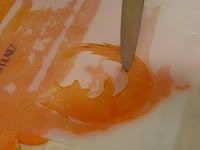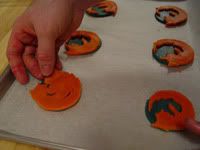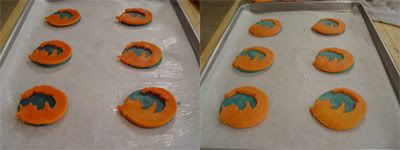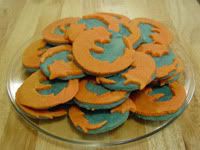According to Google, I've mentioned ganache a couple of times around here. I even gave a quick one-liner at some point on how to make it. As it turns out, there's a lot more to it than just a one line of instruction. Luckily for us, it's still a very simple recipe to put together. Since I'm all about culinary hacking, I decided to take this from a couple of different angles.
First of all, we need to talk about what ganache is. In a nutshell, a classic ganache is an emulsion of equal weights of chocolate and heavy cream. In truth, it doesn't quite need to be all that equal. A higher proportion of cream will make a thin ganache, while more chocolate will make a thick ganache. In my experience, both of these tend to be easier to break than a classic ganache. That means that the ingredients start to seperate from each other and really don't want to get back together. That doesn't mean that you can't get away with a thin or a thick ganache, it just means that you should probably start in the middle.
To start, you'll need to chop up some chocolate. I buy a good deal of my chocolate in ten pound blocks at specialty shops and restaurant supply stores, and then chop what I need when I need it. If you don't have such a supplier nearby, go ahead and go with chocolate chips. But do yourself a favor and check that ingredient list. A really good chocolate will only have cocoa solids, cocoa butter, sugar and sometimes something like lecithin as an emulsifier. If you see any kind of fat other than cocoa butter, put the bag back and look for something else. Also, you don't want to use milk chocolate. We're adding enough dairy as it is with the cream and if you use milk chocolate, it'll just be too much. Go with bittersweet, semisweet, or something else dark. Don't use baking chocolate though. The results will probably not be sweet enough.
If you're like me, you went with the ten pound block. It's cheaper per pound, and is likely to be of a higher quality. Set a corner of it on your cutting board and carefully cut away the chocolate in pieces. Smaller is better, and don't hack at it unless you want to ruin your knife. I have a special chocolate knife that I can use, but today I went with a regular old chef's knife.

I measured my chocolate using a kitchen scale, and you should too. Remember, ganache calls for equal weights of chocolate and heavy cream. I know what you're thinking, and yes, I weighed my cream too. I'm not going to give you exact measurements here, because it doesn't matter. Four ounces of each will work just as well as two pounds. Take your cream and put it on medium-high to high heat. I would recommend doing this after weighing out your chocolate, because it takes much less time for cream to boil than it does to chop enough chocolate for it, and the last thing you want to do is let your cream boil. What you want is a scald. That means that there are just little bubbles breaking around the edges of the cream. When this happens, you might want to stir or swish the cream around a little to make sure it's evenly heated.
Hopefully you've already put your chocolate into a metal bowl, in as flat a layer as possible. Pour your cream on top and let it sit for at least 30 seconds. A couple of minutes would be better. Don't stir anything, don't even shake the bowl. You need to allow time for the heat from the cream to move into the chocolate and melt it.

I hope you have your whisk ready, because now is the time to use it. But be careful! You don't want to incorporate any little air bubbles into your ganache. Whisk slowly, starting from the center. It's going to start off looking like chocolate milk that isn't quite mixed all the way, but keep going. Eventually, the chocolate and the cream in the center will join together in an emulsion, which will look a lot like melted chocolate.


When this happens, you can start moving the whisk out and incorporating more cream, little by little. Don't try to get the whole bowl at once, it just makes it harder for the emulsion to form. And please don't use an electric mixer for this! It's going to incorporate air, and it's not going to do anything to help the emulsion. Before long, you will have a beautiful bowl full of melted ganache.

In this state, the ganache can be poured over ice cream, cakes, anything you like. Let it cool halfway, and then feel free to pull out your electric mixer and give it the spurs, for the best whipped chocolate frosting you've ever had. Let it cool all the way, scoop into little balls, and then toss those little balls in dutched cocoa powder. These are what chocolate truffles originally were, called so because they resemble real truffles, the fungus that they dig up out of the ground in France and charge an arm and a leg for.
Now that you know how to make a classic ganache, let's up the ante a little. I think that those of you who read my posts on dairy percentages and the chocolate raspberry tart have an idea of where I'm going here. That's right, I'm going to hack together my own flavor of cream here. I'm going to go with equal weights of orange juice and butter, heated together on low until the butter is fully melted, and then brought to a scald. Then I'm going to pour that over a bowl of finely chopped chocolate that is equal in weight to the orange juice plus the butter. In other words, if I used four ounces of juice and four ounces of butter, then I'm going to use eight ounces of chocolate.

Go ahead and let it sit for a couple of minutes and then proceed as before, slowly working the center into an emulsion and then slowly working in the rest.

This is a quick and easy way to add a little flavor to your ganache. You don't have to use orange juice, of course. Any juice and some purees will work physically, which is not to say that you'll like the taste. Lime juice would certainly be a good addition, as would raspberry or cranberry. I'm not so sure you'd like what grapefruit brings to the party though, but you're more than welcome to try.
Of course, there is a more traditional way to infuse flavor, and I would be cheating you out of a proper education if I didn't mention it. Let's go back to our original ingredients, equal weights of chocolate and heavy cream. In this recipe, it will be important for you to know that I used four ounces of each, measured by weight. I also added a teaspoon of lavendar petals to the cream, and no more. Remember my folly with the honey lavender ice cream? Go easy on it, or you will be sorry.
Bring the cream to a simmer and then let it sit there for a moment. The longer you let it sit, the stronger the flavor infusion. I let mine sit for somewhere around thirty seconds before removing from the heat and letting it cool for a moment. Keep in mind that a simmer is just above a scald, and you want your cream no hotter than a scald. When you're ready, pour your cream through a strainer into the chocolate.

Let it hang out for a couple of minutes, and then whisk together as before. Wasn't that easy? Of course, you don't have to use lavender. You can use any herb or spice you want, dried or fresh (though you'll probably want to stick with dried). Each one will require different amounts, and different simmering times, so you may want to experiment. Try to use whole herbs and spices when possible. One of the goals of ganache is smoothness, and while powders may seem small to you, they may still be big enough to feel gritty on your tongue. In fact, anything larger than 20 micrometers will probably feel gritty, and even cocoa powder isn't always that small. Suffice it to say that you'll probably be much happier with whole spices. Feel free to toast them first though if you like.
Now you have three different takes on ganache. I made all three in less than half an hour, including chopping, weighing and whisking, so I don't think you should have too many difficulties with it yourself. Is this the last work on ganache? Absolutely not. Those of you who are wondering how well an orange lavender ganache would go over, you're not alone. Give it a shot and tell me what you think! Maybe a little freshly grated ginger would go well with that orange ganache too. Or maybe you could get wild and try using unsweetened baking chocolate, and add some honey to the lavender cream. I'm not sure what the math would be on that one, but you're welcome to give it a try. In fact, I encourage you to give it a try. Make up a practice batch tonight and try it on some ice cream. I don't think you'll be disappointed.















